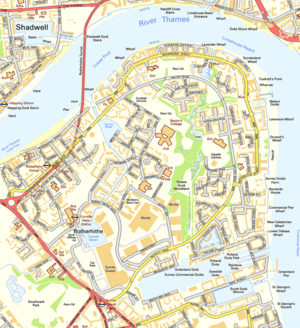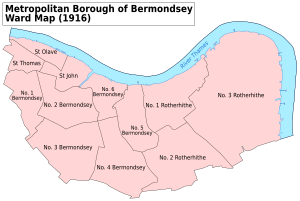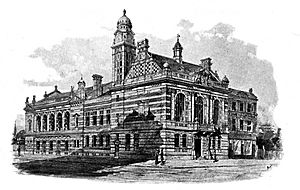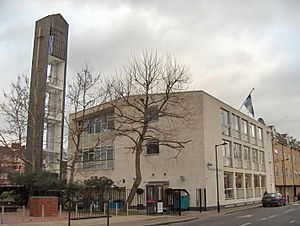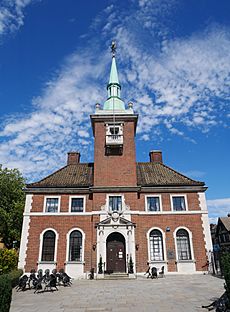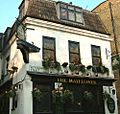Rotherhithe facts for kids
Quick facts for kids Rotherhithe |
|
|---|---|
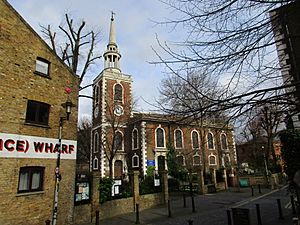 St. Mary's Church, Rotherhithe |
|
| Population | 13,743 (2011 Census. Ward) |
| OS grid reference | TQ358796 |
| London borough | |
| Ceremonial county | Greater London |
| Region | |
| Country | England |
| Sovereign state | United Kingdom |
| Post town | LONDON |
| Postcode district | SE8, SE16 |
| Dialling code | 020 |
| Police | Metropolitan |
| Fire | London |
| Ambulance | London |
| EU Parliament | London |
| UK Parliament |
|
| London Assembly |
|
Rotherhithe is a lively area in South London, England. It's part of the London Borough of Southwark. This district sits on a piece of land that sticks out into the River Thames, like a small peninsula. It faces other areas like Wapping and Limehouse across the river. To its east is the Isle of Dogs, and it's close to Bermondsey and Deptford. Rotherhithe is also part of the famous London Docklands area.
Rotherhithe has a long and interesting past as a port. It had shipyards and busy docks from the time of Queen Elizabeth I until the 1970s. In the 1980s, the riverside areas were changed into homes. Old warehouses were turned into apartments, and new buildings were constructed. Getting around Rotherhithe became much easier when the Jubilee line underground train arrived in 1999. This line connects the area quickly to the West End and Canary Wharf. Later, in 2010, the East London Line became part of the London Overground network, making it simple to reach the City of London. Because of these changes, Rotherhithe is now a popular place to live for people who work in the city. New shops, restaurants, and homes are being built around Canada Water, which is a freshwater dock and a major transport hub.
Rotherhithe is about 4.5 kilometers (2.8 miles) east of London's very center at Charing Cross.
Contents
What's in a Name?
The name "Rotherhithe" comes from an old language called Old English. It means "landing-place for cattle." Imagine a place where cows were brought off boats! The name was first written down around the year 1105. In the past, people also called Rotherhithe "Redriff." This name was used for the whole riverfront area, from St Saviour's Dock to a place near Surrey Water.
Exploring Rotherhithe Today
The old docks in Rotherhithe were closed and mostly filled in during the 1980s. Now, you'll find modern homes and businesses there. But Rotherhithe still feels special and remembers its history with the sea. Greenland Dock is the biggest dock still left on the south bank of the Thames. It's a main spot in the southern part of the area. You can also see many old wharves (places where ships unloaded goods) along the river in northern Rotherhithe.
St. Mary's Church is at the heart of the old Rotherhithe village. Nearby, you can find other historic buildings, including the Brunel Engine House. This building is at the south end of the famous Thames Tunnel.
Canada Dock was once the dock basin furthest from the River Thames in the Surrey Docks area. It was connected to other docks by canals. Today, this dock has been changed. Its northwest part is now a beautiful lake called Canada Water. The old canal is now a walkway and a water feature in the new area.
Rotherhithe is also home to the football team Fisher F.C.. They play their games at St Pauls Stadium. Another well-known team, Millwall Football Club, is located close by in the London Borough of Lewisham.
There are several churches in Rotherhithe. These include two Anglican churches, St. Mary's Church and Trinity Church. There are also two Roman Catholic churches: St Peter and the Guardian Angels, and Our Lady of the Immaculate Conception.
King's Stairs Gardens
King's Stairs Gardens is a small park right by the river, near the border with Bermondsey. In 2011, a company wanted to build a large access shaft for a "super-sewer" tunnel here. However, local people started a campaign and collected many signatures. Because of their efforts, it seems the company will build the shaft somewhere else, if the community agrees.
Famous Places and History
The Mayflower TRA Hall now stands where the old Rotherhithe Town Hall used to be. The town hall stopped being used in 1905 when Rotherhithe Council joined with another council. The old building then became a library and a museum. Sadly, it was completely destroyed by bombs during the Second World War.
Rotherhithe also had its own hospital, St Olave's Hospital. It was built in the 1870s and closed in 1985. The land where it stood has now been turned into homes.
The Terriss Theatre, later called the Rotherhithe Hippodrome, opened in 1899. It was bombed in the 1940s and torn down in 1955.
When the area around the Rotherhithe Tunnel was rebuilt in the 1980s, some old 19th-century buildings were knocked down. This included a school, a nunnery, and a very old pub called the "Europa."
The Daily Mail and Evening Standard newspapers were printed at Harmsworth Quays in Rotherhithe from 1989 to 2012. This site is now a popular events venue called the Printworks.
Nordic Connections
Many years ago, the old Surrey Docks had strong trade links with countries in Scandinavia and the Baltic Sea region. Because of this, Rotherhithe still has a lively Scandinavian community. During World War II, the Norwegian government even stayed here while their country was occupied.
Rotherhithe is home to a Norwegian, a Finnish, and a Swedish church. These churches were first set up to help sailors. The Finnish Church and the Norwegian Church are both on Albion Street. You can also find community centers for the Nordic people in London, with hostels, shops, cafés, and even a sauna.
Some of the newer buildings in Rotherhithe were designed by architects from Nordic countries. This gives parts of the area a special "Nordic" look. You can also see the connection to Scandinavia and the Baltic in street names like Finland Street, Sweden Gate, and Norway Gate. Trade with Russia and Canada (especially timber) also influenced names like Canada Water and the Russia Dock Woodland.
The Mayflower Ship
In July 1620, the famous ship Mayflower sailed from Rotherhithe. It picked up 65 passengers, likely from Blackwall, before heading to Southampton. There, it loaded food and supplies for its long journey to America. The "Pilgrim Fathers" (English Separatists) were living in the Netherlands at the time. They hired a ship called the Speedwell to take them from Delfshaven to Southampton to meet the Mayflower.
The Mayflower's captain, Christopher Jones, died in 1621 and is buried at St Mary's Church. No one knows exactly where the Mayflower was docked in Rotherhithe. However, the Mayflower pub near St Mary's Church claims this honor. The pub has the names of the Mayflower passengers on its wall. The building itself was built in the 1950s, after the original was damaged during the Second World War.
China Hall
On Lower Road, there used to be a pub called the China Hall. It was once the entrance to a riverside theater that the famous diarist Samuel Pepys visited. The theater was later destroyed by fire in 1779. The site then became a popular tea garden. By the 1920s, most of the gardens were taken over by the Surrey Commercial Docks.
Rotherhithe in World War II
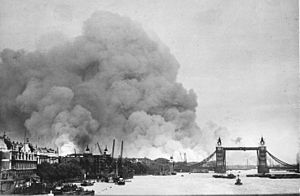
Like other parts of the London Docks, the Surrey Commercial Docks were a target for German planes during the Second World War. On September 7, 1940, the very first day of the London Blitz, the timber yards of Surrey Docks caught fire. Over a million tons of wood burned, creating the biggest single fire ever seen in Britain.
The old Rotherhithe Town Hall was hit many times during the war. It was damaged by bombs in 1941 and 1944. Later in June 1944, it was severely damaged by a direct hit from a V1 doodlebug. It was finally destroyed by one of the last V1 bombs to land on London during the war.
King Haakon VII of Norway made many of his famous radio broadcasts to occupied Norway from Saint Olav's Norwegian Church in Rotherhithe. The Norwegian Royal Family often worshipped there during their time in London.
How to Get Around Rotherhithe
Rotherhithe is connected to the north bank of the Thames by three tunnels. The Thames foot tunnel to Wapping was the first underwater tunnel in the world. It was built by the Brunels and was originally meant for goods, but it became a pedestrian tunnel. Later, it was used for trains and is now part of the London Overground network.
The Rotherhithe Tunnel (opened in 1908) carries a two-lane road to Limehouse. The Jubilee line underground extension (opened in 1999) has a railway tunnel to Canary Wharf.
Rotherhithe is part of the SE16 postcode area.
|
Famous People from Rotherhithe

Many well-known people have connections to Rotherhithe:
- Marc Isambard Brunel (1769–1849) and his son Isambard Kingdom Brunel (1806–1859) built the amazing Thames Tunnel here.
- Max Bygraves (1922–2012), a famous entertainer, was born in Rotherhithe.
- Michael Caine (born 1933), the well-known actor, was also born in Rotherhithe.
- Thomas Coram (1668–1751), a sea captain who helped others, lived here and worked to set up the Foundling Hospital.
- Malcolm Hardee (1950–2005), a comedian, lived on a houseboat in Greenland Dock.
- Myleene Klass (born 1978), a singer, lived in Rotherhithe in the early 2000s.
- Sean Lock (1963–2021), a comedian, lived here in the 1990s.
- Aaron Manby (1776–1850) put together and launched the world's first iron-hulled ship that could sail at sea, right here in 1822.
- Billy Mehmet (born 1985), a professional footballer, went to Bacon's College in Rotherhithe.
- David Haye (born 1980), a professional boxer, also attended Bacon's College.
- King Mutesa II of Buganda (1925–1969) died in his flat in Rotherhithe while living in exile.
- James Walker (1781–1862) helped design and build Greenland Dock. There's a statue of him there.
Places to See
- Brunel Engine House
- Finnish Church
- Canada Water
- Southwark Park
- Greenland Dock
- Russia Dock Woodland
- South Dock
- Stave Hill (which includes an Ecological Park)
- St. Mary's Church
- Thames Tunnel
- Surrey Docks Farm
- Nelson Dock Pier
- King Edward III’s Manor House
Getting Around Rotherhithe
Train Stations
Rotherhithe has three train stations:
- Rotherhithe railway station was once an underground station. It was rebuilt and reopened in 2010 as a London Overground station. It's close to the river.
- Surrey Quays railway station is in the southern part of the area. It also changed from an underground station to an Overground station at the same time as Rotherhithe station.
- Canada Water tube station is in central Rotherhithe. It's a very important place to change trains, as both the London Overground and the Jubilee line of the London Underground stop here. There's also a bus station. This area is seeing many new flats being built.
Other nearby stations include Bermondsey tube station (Jubilee line), South Bermondsey railway station, and London Bridge railway station.
Buses
Many Transport for London bus services run through Rotherhithe, including routes 1, 47, 188, 199, 225, 381, C10, and P12. night buses N1, N199, and N381 also stop here. Canada Water bus station is a major stop because it's so close to the train station.
Walking and Cycling
You can walk or cycle along the riverbank on the Thames Path. Most of the riverbank is open to the public. A new bridge for walkers and cyclists has been suggested to connect Rotherhithe and Canary Wharf.
River Boats
- Greenland Dock Pier is served by Thames Clippers boats, which are a fun way to travel along the river.
- Docklands Pier is used for the Canary Wharf – Rotherhithe Ferry.
| Preceding station | Following station | |||
|---|---|---|---|---|
| Canary Wharf Pier
Terminus
|
RB4 | Terminus | ||
| Canary Wharf Pier
towards Battersea Power Station Pier
|
RB1 | Masthouse Terrace Pier
towards Barking Riverside Pier
|
||
Images for kids
See also
 In Spanish: Rotherhithe para niños
In Spanish: Rotherhithe para niños



